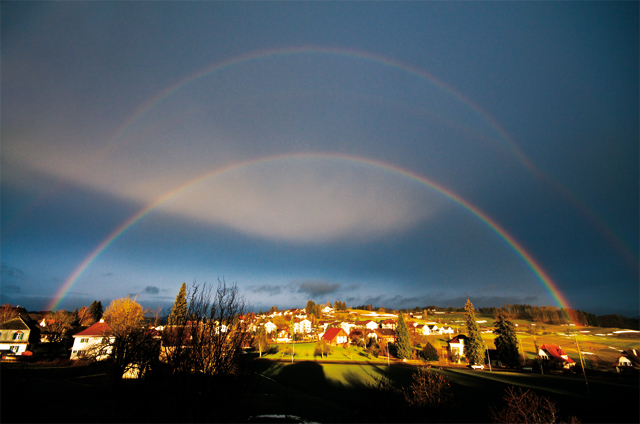Explanation
Over bodies of water, in addition to the main and secondary rainbow, further unusual rainbows are sometimes observed. These are rainbows created by reflected sunlight. Together with the ordinary rainbow, very complex rainbow phenomena can appear at first glance, where up to four rainbows are simultaneously visible and partially overlap.
The formation of the additional main and secondary rainbow can easily be explained: The water surface acts as a large mirror. The sun's reflection is located just as far below the horizon as the sun is above it (angle of incidence = angle of reflection). The antisolar point of the reflected sun is therefore above the horizon. This point, which is located twice the solar altitude above the antisolar point, is the center of the two rainbow circles of the reflected sunlight. The additional rainbows are therefore shifted upwards by twice the solar altitude compared to the usual main and secondary rainbow.
A calm water surface is a prerequisite for the formation. Even with light waves, the sun's rays diverge too strongly to create a noticeable "mirror rainbow". Therefore, in most rainbow photos over the sea, no additional rainbow is visible. Good conditions can be found at lakes when there is no wind. But even the many puddles that form after a heavy downpour could reflect enough light that a lake or sea nearby is not necessarily required. Perhaps one should try to specifically look for these unusual rainbows. A rainbow can often be predicted 15 minutes before it appears. Then you drive to the nearest lake and wait with a ready camera for the rainbow. Ideally, the lake should be in front of the observer when looking towards the rainbow. Then, the additional arc fragment at the base of the usual rainbow can be expected. But even with the lake behind, the unusual rainbows can also occur. In this case, one is more likely to see the upper part of the "mirror rainbow".
I am also aware of some old observations in which, in addition to the usual rainbow, a laterally offset rainbow occurred. As long as there are no photos of this, I consider these observations very questionable. In this case, the reflective surface would have to be tilted. Nowadays, such laterally offset rainbows may occur due to large reflective building facades. For observations from the 19th century and earlier, I have no explanation. One might only think of very elongated waves on the sea that could form an inclined plane, or mountain slopes covered with snow and ice.
A calm water surface is a prerequisite for the formation. Even with light waves, the sun's rays diverge too strongly to create a noticeable "mirror rainbow". Therefore, in most rainbow photos over the sea, no additional rainbow is visible. Good conditions can be found at lakes when there is no wind. But even the many puddles that form after a heavy downpour could reflect enough light that a lake or sea nearby is not necessarily required. Perhaps one should try to specifically look for these unusual rainbows. A rainbow can often be predicted 15 minutes before it appears. Then you drive to the nearest lake and wait with a ready camera for the rainbow. Ideally, the lake should be in front of the observer when looking towards the rainbow. Then, the additional arc fragment at the base of the usual rainbow can be expected. But even with the lake behind, the unusual rainbows can also occur. In this case, one is more likely to see the upper part of the "mirror rainbow".
I am also aware of some old observations in which, in addition to the usual rainbow, a laterally offset rainbow occurred. As long as there are no photos of this, I consider these observations very questionable. In this case, the reflective surface would have to be tilted. Nowadays, such laterally offset rainbows may occur due to large reflective building facades. For observations from the 19th century and earlier, I have no explanation. One might only think of very elongated waves on the sea that could form an inclined plane, or mountain slopes covered with snow and ice.
It seems plausible to apply the principle of the "mirror bow" to halo phenomena as well. In winter, a smooth ice surface could reflect enough sunlight to produce halo phenomena in low-lying ice fog. Additionally, I consider it possible that the ice crystals themselves serve as mirrors for the sunlight. These would then be secondary halos to the subsun. Even though I generally do not think much of secondary halos, for example, attempts are made to explain the 46° parhelion as a secondary halo phenomenon to the parhelion, the top side of ice crystals could reflect enough light to produce halo phenomena. However, observations of this type do not exist so far.

